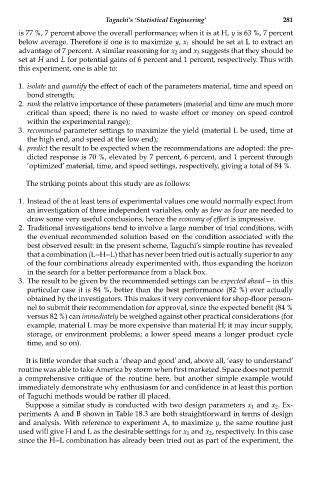Page 296 - Six Sigma Advanced Tools for Black Belts and Master Black Belts
P. 296
OTE/SPH
OTE/SPH
Char Count= 0
3:6
August 31, 2006
JWBK119-18
Taguchi’s ‘Statistical Engineering’ 281
is 77 %, 7 percent above the overall performance; when it is at H, y is 63 %, 7 percent
below average. Therefore if one is to maximize y, x 1 should be set at L to extract an
advantage of 7 percent. A similar reasoning for x 2 and x 3 suggests that they should be
set at H and L for potential gains of 6 percent and 1 percent, respectively. Thus with
this experiment, one is able to:
1. isolate and quantify the effect of each of the parameters material, time and speed on
bond strength;
2. rank the relative importance of these parameters (material and time are much more
critical than speed; there is no need to waste effort or money on speed control
within the experimental range);
3. recommend parameter settings to maximize the yield (material L be used, time at
the high end, and speed at the low end);
4. predict the result to be expected when the recommendations are adopted: the pre-
dicted response is 70 %, elevated by 7 percent, 6 percent, and 1 percent through
‘optimized’ material, time, and speed settings, respectively, giving a total of 84 %.
The striking points about this study are as follows:
1. Instead of the at least tens of experimental values one would normally expect from
an investigation of three independent variables, only as few as four are needed to
draw some very useful conclusions, hence the economy of effort is impressive.
2. Traditional investigations tend to involve a large number of trial conditions, with
the eventual recommended solution based on the condition associated with the
best observed result: in the present scheme, Taguchi’s simple routine has revealed
that a combination (L--H--L) that has never been tried out is actually superior to any
of the four combinations already experimented with, thus expanding the horizon
in the search for a better performance from a black box.
3. The result to be given by the recommended settings can be expected ahead -- in this
particular case it is 84 %, better than the best performance (82 %) ever actually
obtained by the investigators. This makes it very convenient for shop-floor person-
nel to submit their recommendation for approval, since the expected benefit (84 %
versus 82 %) can immediately be weighed against other practical considerations (for
example, material L may be more expensive than material H; it may incur supply,
storage, or environment problems; a lower speed means a longer product cycle
time, and so on).
It is little wonder that such a ‘cheap and good’ and, above all, ‘easy to understand’
routine was able to take America by storm when first marketed. Space does not permit
a comprehensive critique of the routine here, but another simple example would
immediately demonstrate why enthusiasm for and confidence in at least this portion
of Taguchi methods would be rather ill placed.
Suppose a similar study is conducted with two design parameters x 1 and x 2 . Ex-
periments A and B shown in Table 18.3 are both straightforward in terms of design
and analysis. With reference to experiment A, to maximize y, the same routine just
used will give H and L as the desirable settings for x 1 and x 2 , respectively. In this case
since the H--L combination has already been tried out as part of the experiment, the

